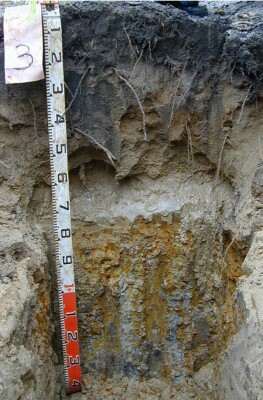GHF02c
Location: Cavendish
Australian Soil Classification: Grey CHROMOSOL (Very thick sandy surface horizons)
General Landscape Description: Plain
Site Description: Flat
Land Unit: Grampians Alluvial
Geology: Quaternary alluvial
General Land Unit Description: This land unit consists of the alluvial plains around the Grampians. The soils are commonly poorly drained Grey Sodosols in association with Podosols. Some areas experience months of inundation. These soils are commonly Hydrosols. The vegetation is mainly thick scrubby tea tree on the wetter soils.
This site is near the base of the Grampians, and it appears that water drains onto the alluvial plains from the Grampians. Apparently groundwater closer to the Grampians (about 1 km to the east) is at a depth of 3 m. Currently there exists a 1.5 year old E. globulus plantation on ex-agricultural land.
Soil Profile Morphology
| A1 | 0-25 cm | Black (10YR2/1) loamy sand, single grain structure, loose consistence when moist, many coarse roots. Clear and wavy transition to: |  |
| A2 | 25-80 cm | Light yellowish brown (10YR6/4) with few medium faint reddish yellow (7.5YR6/6) mottles, loamy sand, single grain structure, loose consistence when wet, many medium roots. Sharp and smooth transition to: | |
| Subsoil | |||
| B1 | 80-95 cm | Pale brown (10YR6/3) with many medium distinct strong brown (7.5YR5/8) and red (2.5YR5/6) mottles, sandy clay, weak polyhedral structure (20-50 mm), firm consistence when moderately moist, very few medium ferruginous nodules, common very fine macropores, areal porosity 0.3%, few very fine roots. Clear and wavy transition to: | |
| B21 | 95-125 cm | Very pale brown (10YR7/1) with many coarse prominent yellowish brown (10YR5/8) and red (2.5YR4/6) mottles, medium clay (with sand), weak polyhedral structure (50-100 mm), firm consistence when moderately moist, few very fine macropores, aereal porosity 0.1%, few very fine roots. Gradual and smooth transition to: | |
| B22 | 125-150 cm | Light grey (10YR8/1) with many very coarse prominent yellow (10YR5/8) and red (2.5YR4/6) mottles, heavy clay (with sand), moderate polyhedral structure (50-100 mm), very firm consistence when moderately moist, few coarse ferromanganiferous nodules, few very fine macropores, areal porosity 0.1%, few very fine roots. | |
| 150-430 cm | Appears to be wet with remnant roots to 300 cm, sand increasing with depth, heavy clay, then sandy clay/clayey sand, no impeding layer apart from heavy clay at 125 cm, clayey sand from 300 cm, paler with depth, almost grey-white, | ||
Key Profile Features:
- Strong texture contrast between sandy surface (A) horizons and sandy clay subsoil.
- Very thick sandy surface (A) horizons
Soil Profile Characteristics:
- | pH | Salinity |
Surface Soil (A1 horizon) | Very Strongly Acid | Very Low |
Subsoil (B1 cm) | Slightly Acid | Very Low |
Deeper Subsoil (95-125 cm) | Slightly Alkaline | Very Low |
Chemical and Physical Analysis:
Horizon | Horizon Depth (cm) | pH (water) | pH (CaCl2) | EC dS/m |
A1 | 0-25 | 4.9 | 4.3 | <0.05 |
A2 | 25-80 | 6.0 | 5.2 | <0.05 |
B1 | 80-95 | 6.9 | 5.8 | 0.10 |
B21 | 95-125 | 7.1 | 6.2 | 0.18 |
Profile Described By: Ian Sargeant, Paul Feikema, Martin Clark and Kiet Quach, 26th October 2000.


